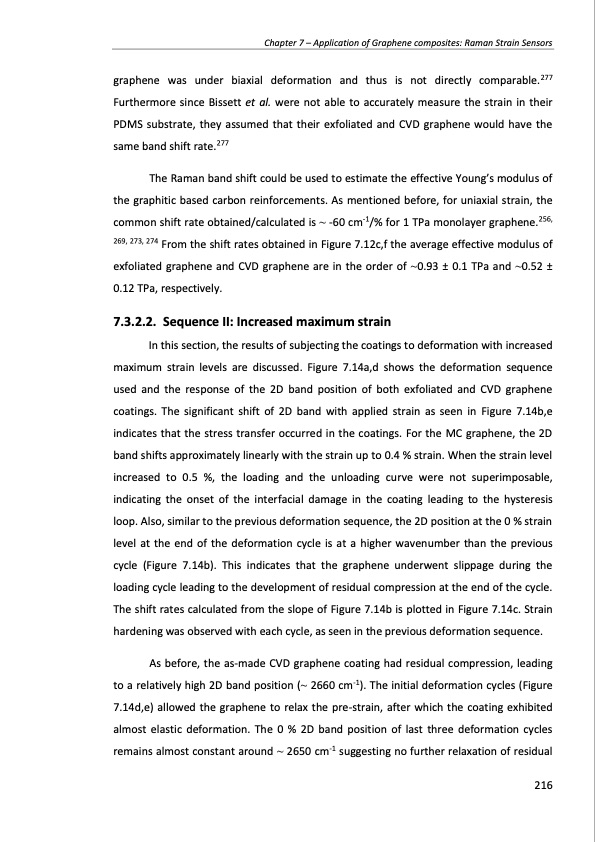PDF Publication Title:
Text from PDF Page: 216
Chapter 7 – Application of Graphene composites: Raman Strain Sensors graphene was under biaxial deformation and thus is not directly comparable.277 Furthermore since Bissett et al. were not able to accurately measure the strain in their PDMS substrate, they assumed that their exfoliated and CVD graphene would have the same band shift rate.277 The Raman band shift could be used to estimate the effective Young’s modulus of the graphitic based carbon reinforcements. As mentioned before, for uniaxial strain, the common shift rate obtained/calculated is ~ -60 cm-1/% for 1 TPa monolayer graphene.256, 269, 273, 274 From the shift rates obtained in Figure 7.12c,f the average effective modulus of exfoliated graphene and CVD graphene are in the order of ~0.93 ± 0.1 TPa and ~0.52 ± 0.12 TPa, respectively. 7.3.2.2. Sequence II: Increased maximum strain In this section, the results of subjecting the coatings to deformation with increased maximum strain levels are discussed. Figure 7.14a,d shows the deformation sequence used and the response of the 2D band position of both exfoliated and CVD graphene coatings. The significant shift of 2D band with applied strain as seen in Figure 7.14b,e indicates that the stress transfer occurred in the coatings. For the MC graphene, the 2D band shifts approximately linearly with the strain up to 0.4 % strain. When the strain level increased to 0.5 %, the loading and the unloading curve were not superimposable, indicating the onset of the interfacial damage in the coating leading to the hysteresis loop. Also, similar to the previous deformation sequence, the 2D position at the 0 % strain level at the end of the deformation cycle is at a higher wavenumber than the previous cycle (Figure 7.14b). This indicates that the graphene underwent slippage during the loading cycle leading to the development of residual compression at the end of the cycle. The shift rates calculated from the slope of Figure 7.14b is plotted in Figure 7.14c. Strain hardening was observed with each cycle, as seen in the previous deformation sequence. As before, the as-made CVD graphene coating had residual compression, leading to a relatively high 2D band position (~ 2660 cm-1). The initial deformation cycles (Figure 7.14d,e) allowed the graphene to relax the pre-strain, after which the coating exhibited almost elastic deformation. The 0 % 2D band position of last three deformation cycles remains almost constant around ~ 2650 cm-1 suggesting no further relaxation of residual 216PDF Image | PRODUCTION AND APPLICATIONS OF GRAPHENE AND ITS COMPOSITES

PDF Search Title:
PRODUCTION AND APPLICATIONS OF GRAPHENE AND ITS COMPOSITESOriginal File Name Searched:
graphene-production-applications.PDFDIY PDF Search: Google It | Yahoo | Bing
Salgenx Redox Flow Battery Technology: Power up your energy storage game with Salgenx Salt Water Battery. With its advanced technology, the flow battery provides reliable, scalable, and sustainable energy storage for utility-scale projects. Upgrade to a Salgenx flow battery today and take control of your energy future.
CONTACT TEL: 608-238-6001 Email: greg@infinityturbine.com (Standard Web Page)